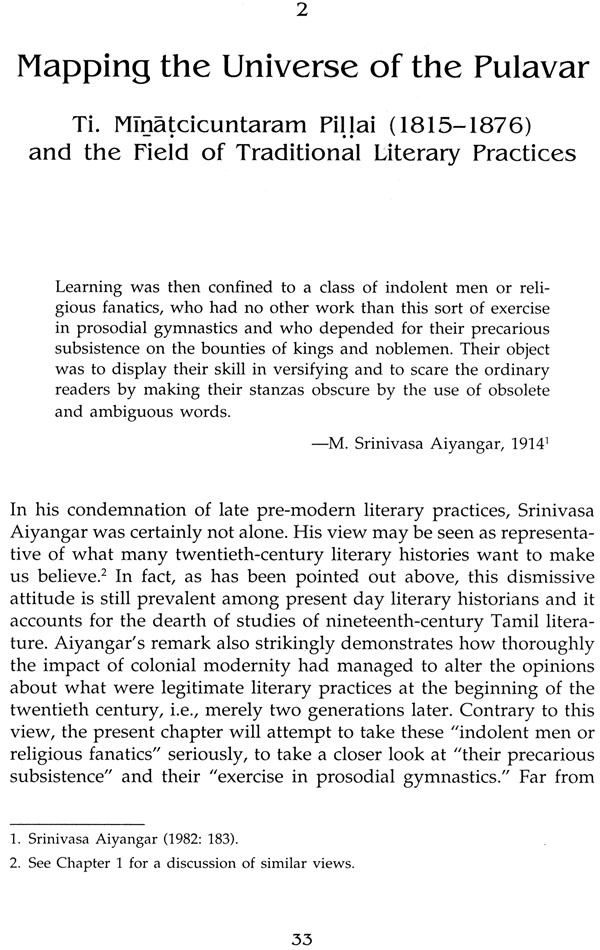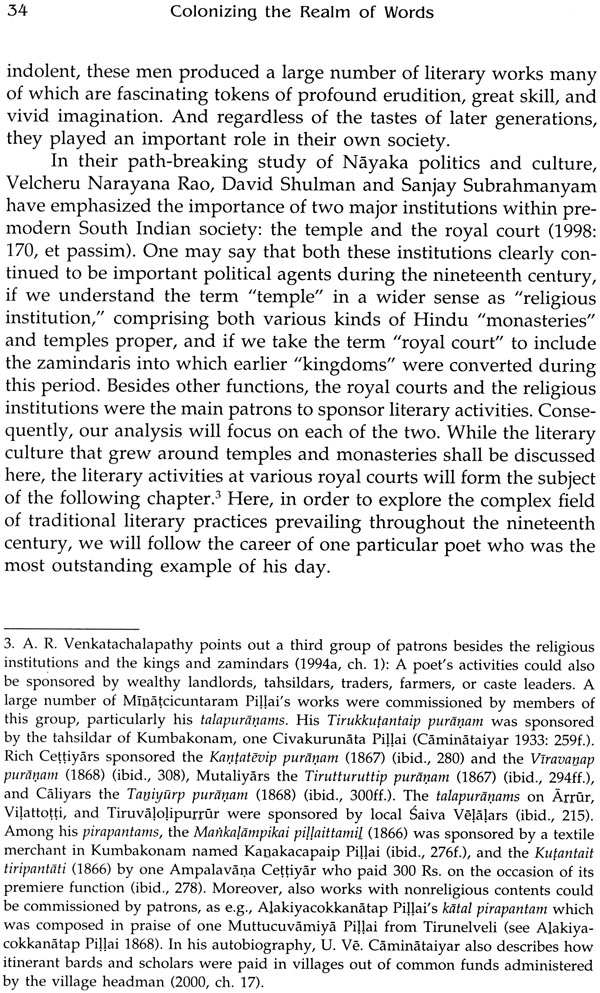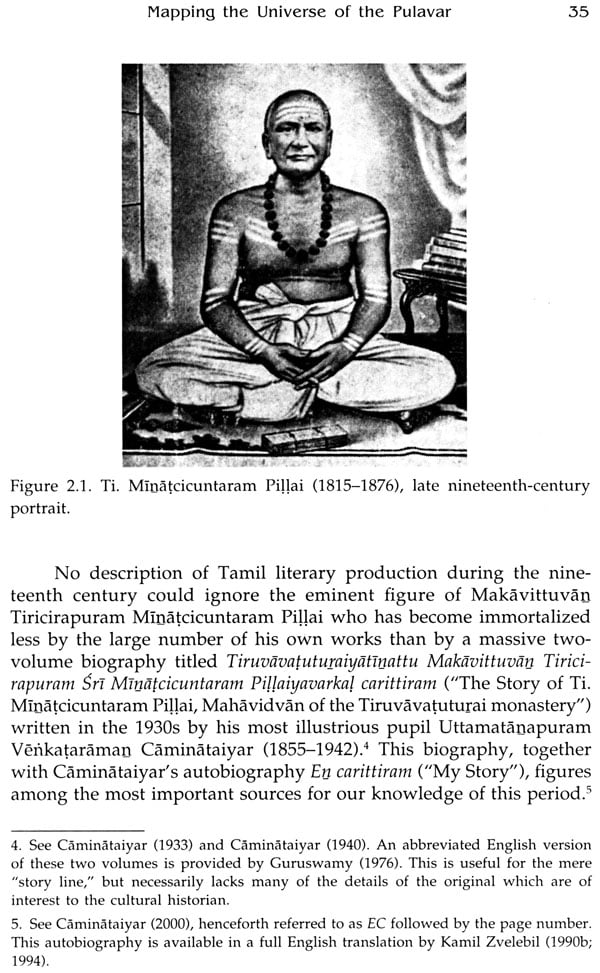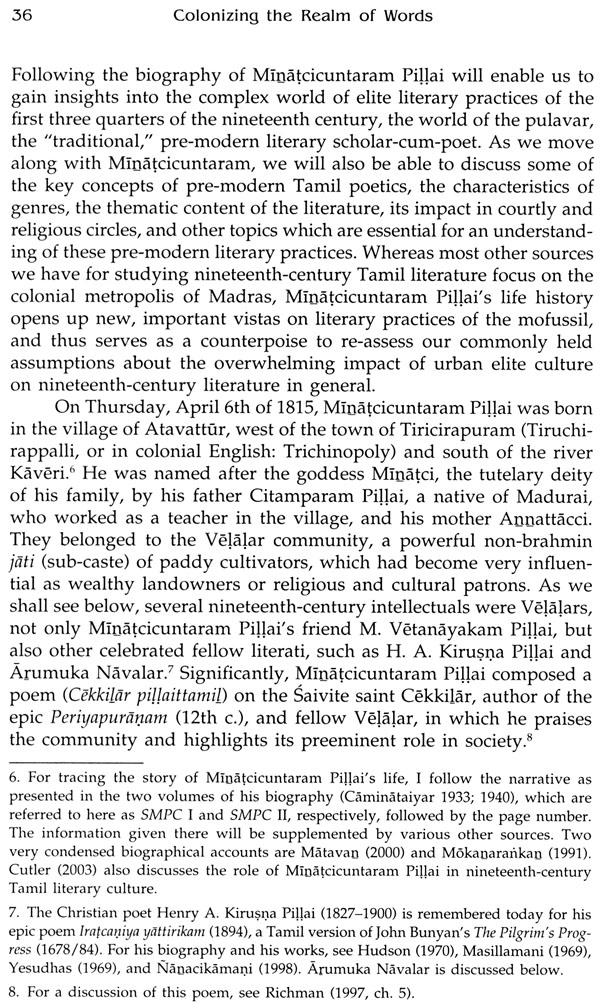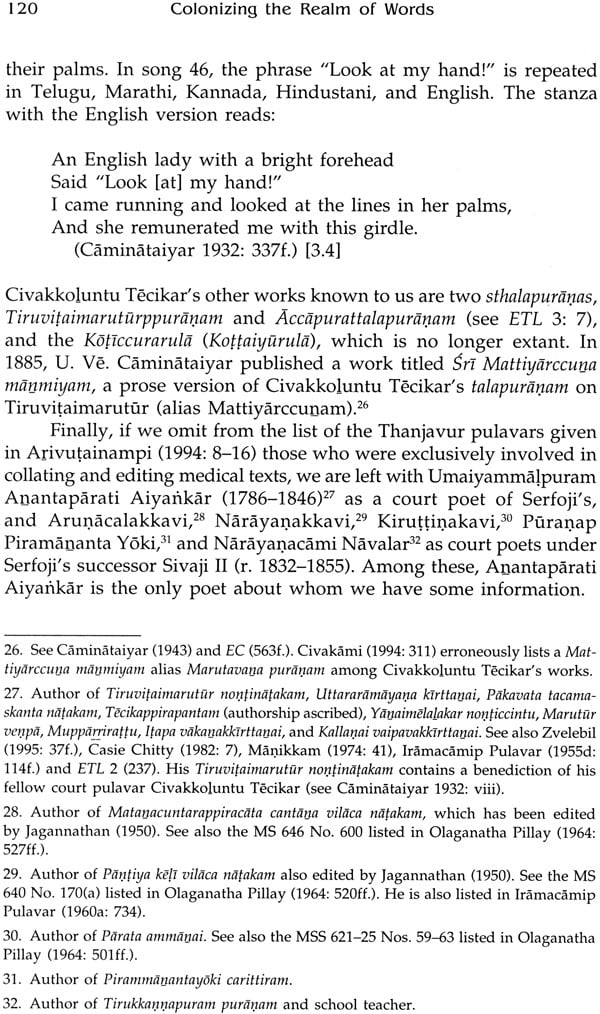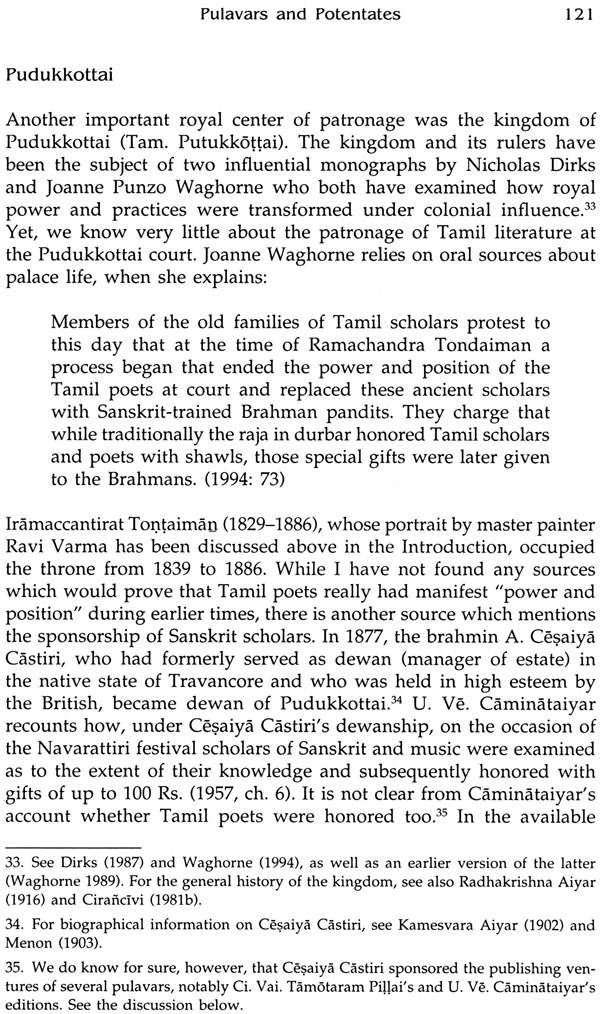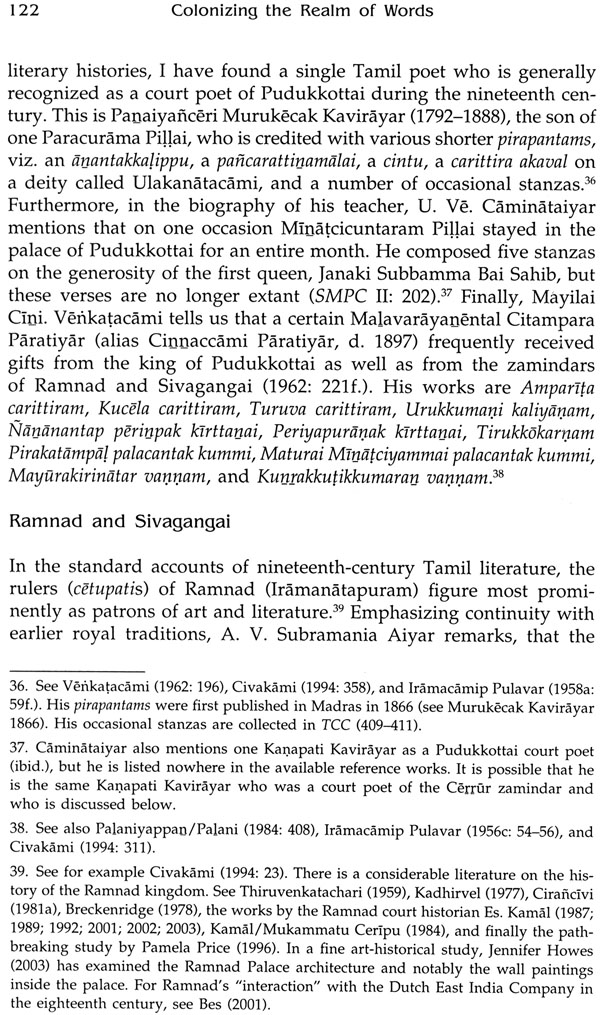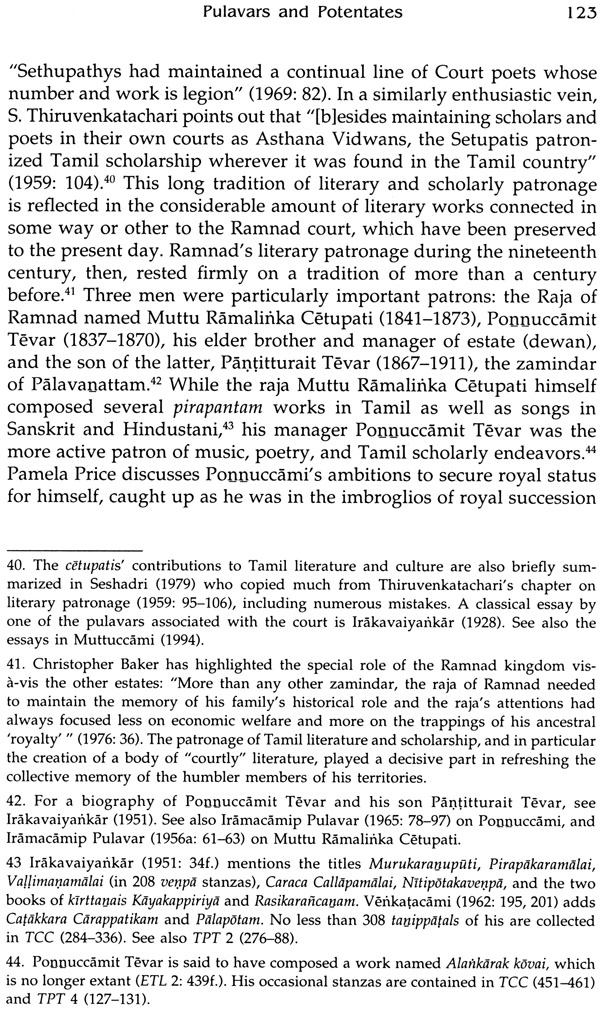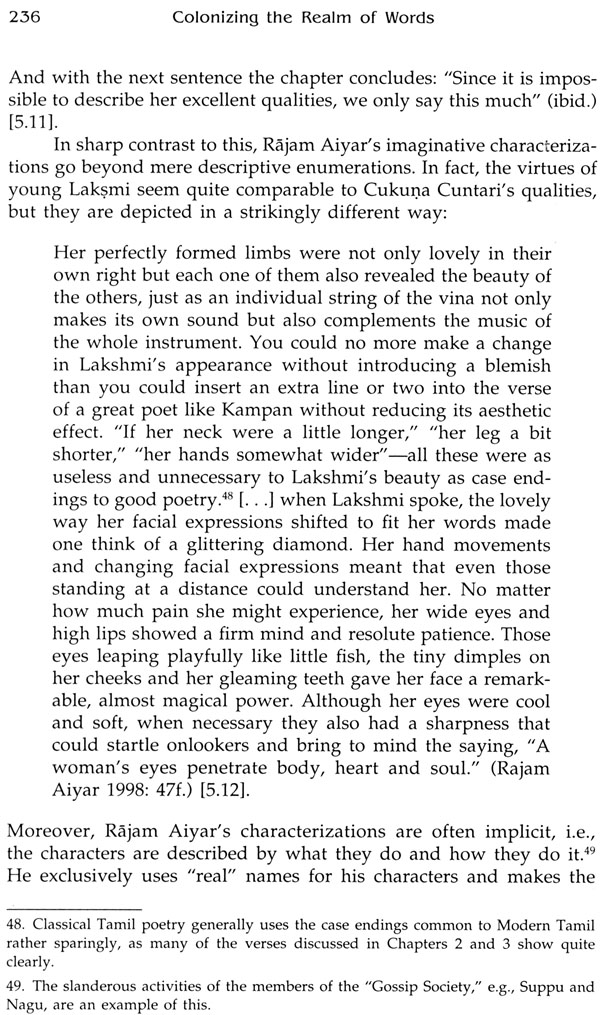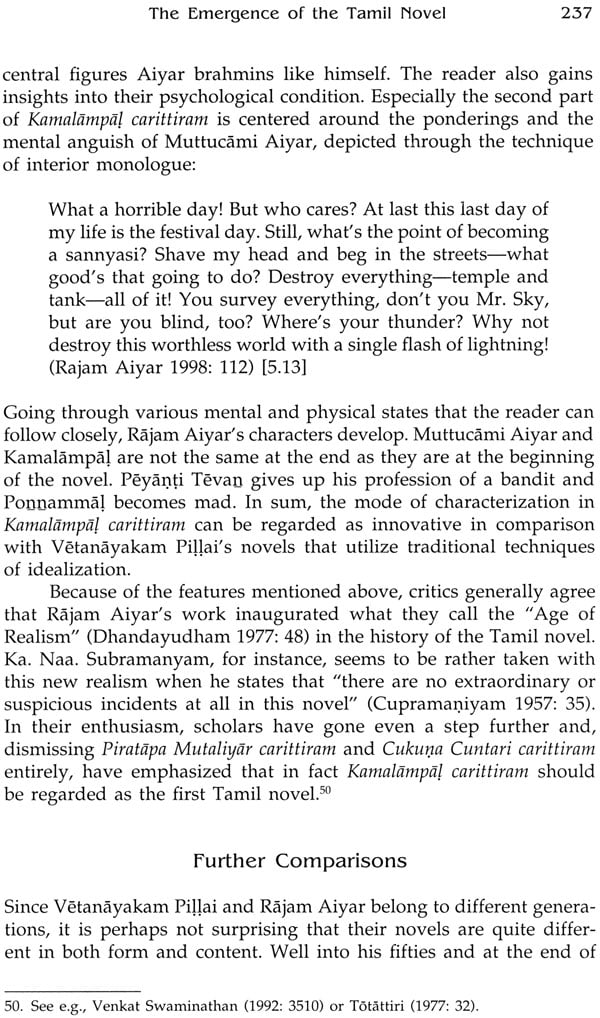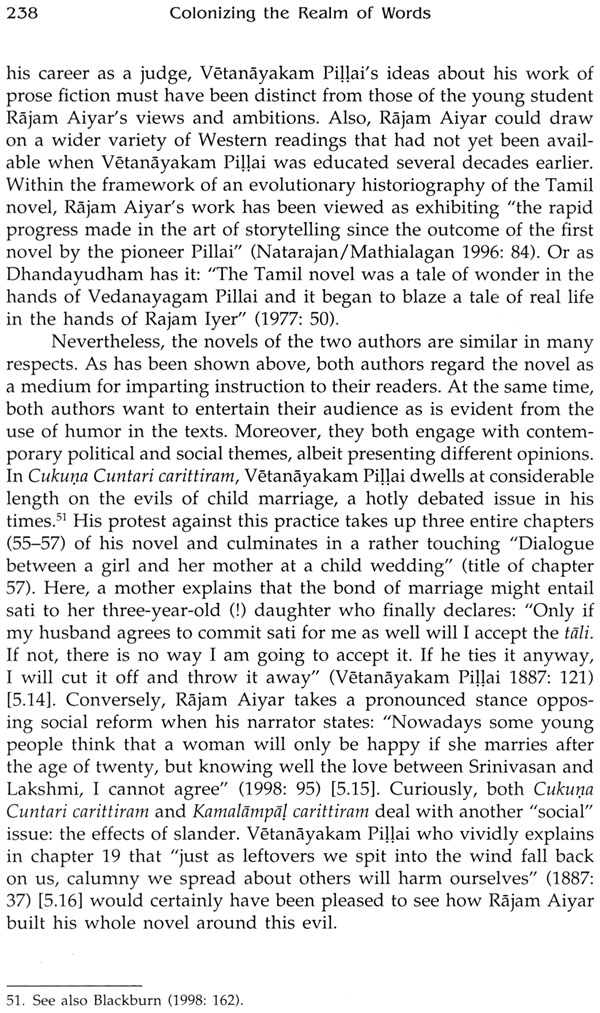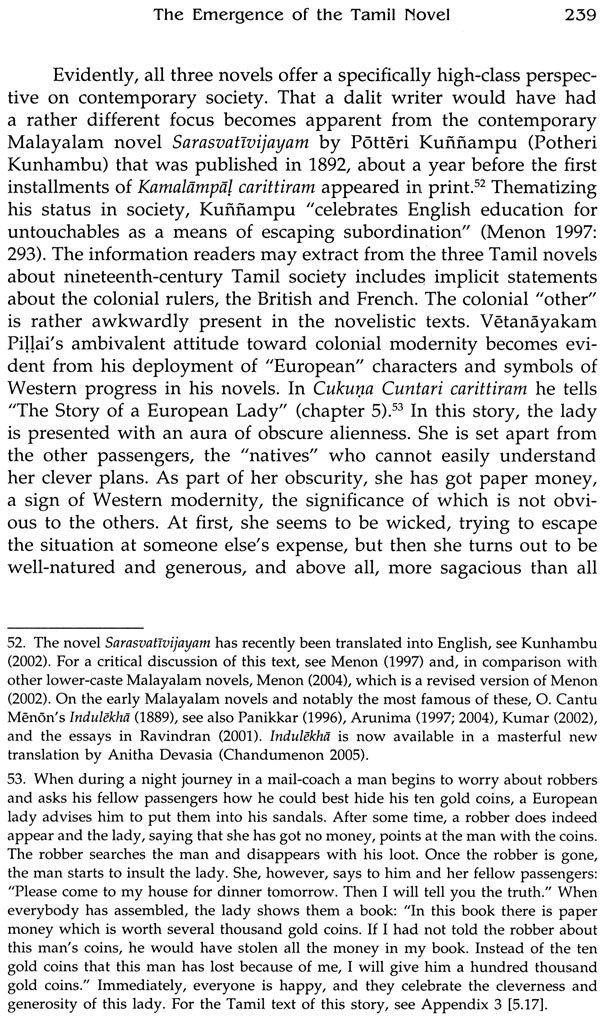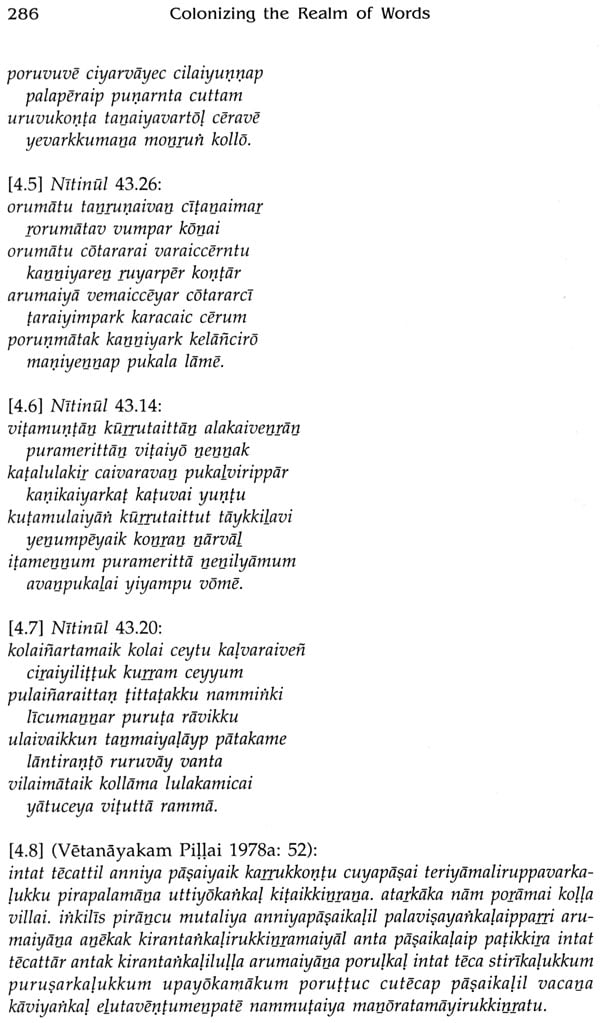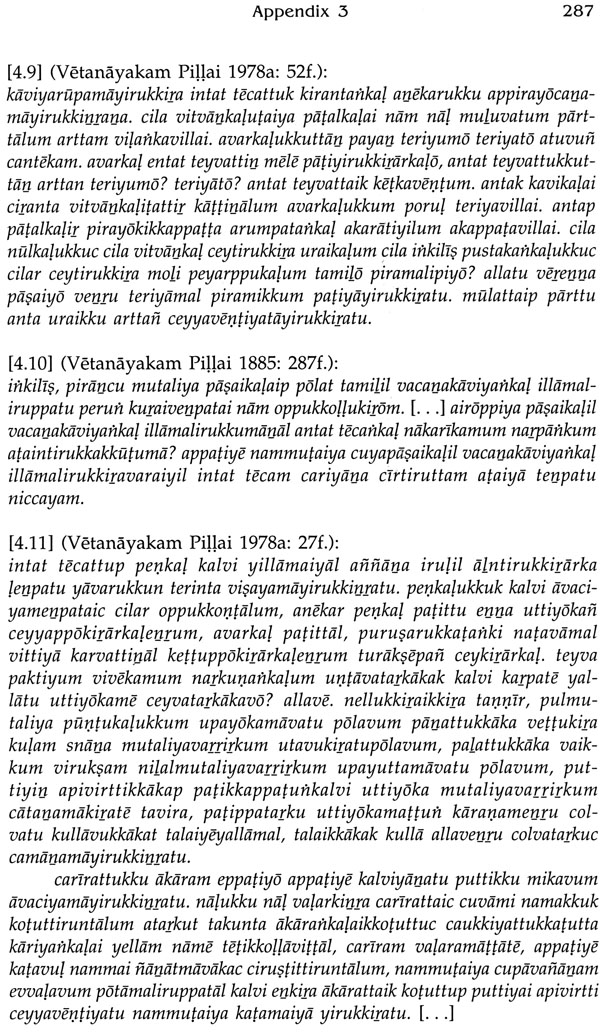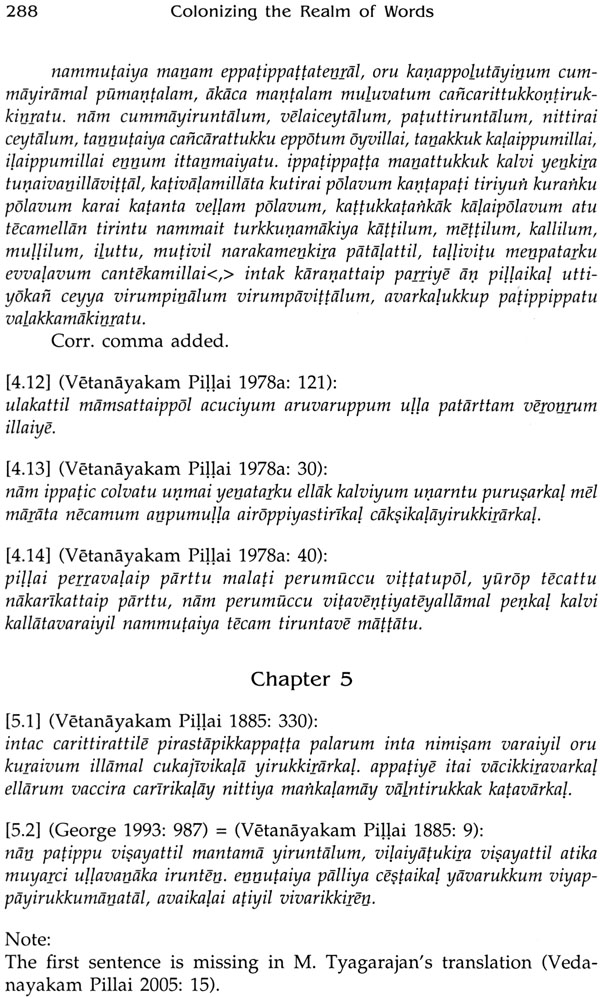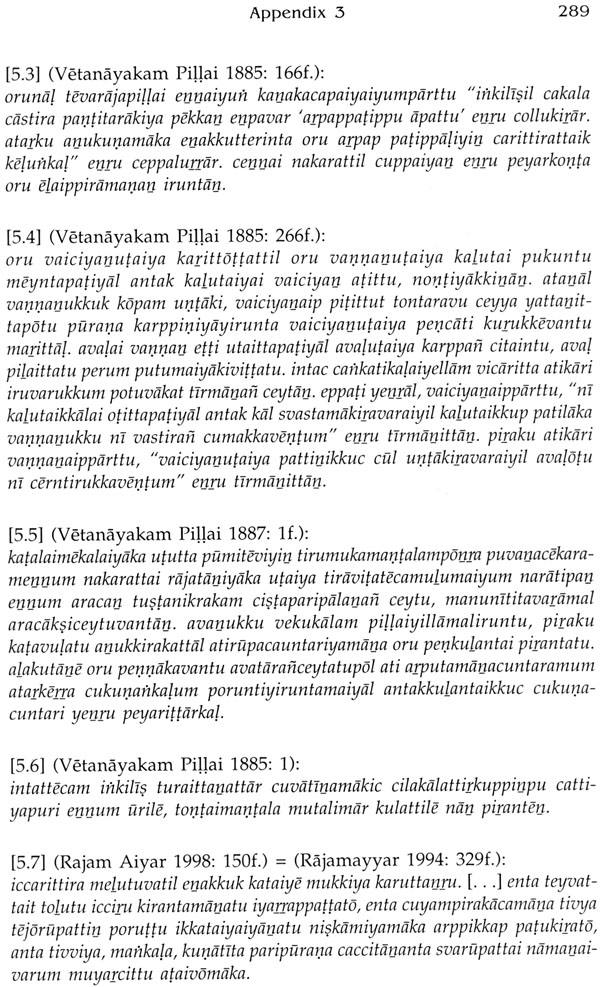
Colonizing the Realm of Words (The Transformation of Tamil Literature in Nineteenth- Century South India)
Book Specification
| Item Code: | NAG091 |
| Author: | Sascha Ebeling |
| Publisher: | Dev Publishers and Distributors |
| Language: | English |
| Edition: | 2013 |
| ISBN: | 9789381406137 |
| Pages: | 378 (4 B/W Illustrations) |
| Cover: | Hardcover |
| Other Details | 9 inch X 6.5 inch |
| Weight | 550 gm |
Book Description
About the Book
A true tour de force, this book documents the transformation of one Indian literature, Tamil, under the impact of colonialism and Western modernity. While Tamil is a living language, it is also India's second oldest classical language next to Sanskrit, and has a literary history that goes back over two thousand years. On the basis of extensive archival research, Sascha Ebeling tackles a host of issues pertinent to Tamil elite literary production and consumption during the nineteenth century. These include the functioning and decline of traditional systems in which poet-scholars were patronized by religious institutions, landowners, and local kings; the anatomy of changes in textual practices, genres, styles, poetics, themes, tastes, and audiences; and the role of literature in the politics of social reforms, gender, and incipient nationalism. The work concludes with a discussion of the most striking literary development of the time the emergence of the Tamil novel.
About the Author
Sascha Ebeling is Assistant Professor of South Asian Languages and Civilizations at the University of Chicago.
Preface
Colonialism transformed many things, inexorably, decisively. But what about ways of narrating and listening, of reading and writing, of using one's imagination to do things with words? What about literature? How can the realm of words, the language we use and what we do with it, be colonized? During the course of the nineteenth century, all of India's literatures were thoroughly transformed under the impact of colonialism and Western modernity. This book examines the complexities of this momentous transformation by focusing on the case of Tamil, India's second oldest classical language besides Sanskrit. Based on extensive archival research and a wealth of textual material, this book tackles a variety of issues pertinent to Tamil elite literary production and consumption during the nineteenth century: the functioning and decline of traditional systems of literary production in which poet-scholars were patronized by religious institutions, landowners, and local kings; the anatomy of changes in textual practices, genres, styles, poetics, themes, tastes, and audiences; and the role of literature in the politics of social reform, gender, and incipient nationalism. By concluding with a discussion of what was at the time the most striking new genre- the Tamil novel-this book illuminates the larger picture of nineteenth-century Tamil literary culture.
Many of the questions discussed below are of course not limited to Tamil literature alone, but rather equally concern other literatures of South Asia or even other regions. In what follows, I have therefore tried to point to parallels and analogies as mush and often as the scope of this book permitted. But I am aware that what I could only allude to or mention in passing would require a much more detailed comparative discussion-a discussion that could not be the aim of the preset work and that, in any case, would presuppose in-depth studies of other literatures that we do not yet posses. Also, Tamil presents a special case. As the only living Indian language with over two thousand years of documented literary activity; it provides us with a particularly rich archive-an archive that scholars have only just begun to explore. Many areas on the map of Tamil literary history are still blank. In writing about the nineteenth century, I am exploring one such largely uncharted terrain, a terrain that, for a long time, has been actively dismissed as "the dark period" of Tamil literature and that has only recently begun to receive due attention. I will return to that problem in the Introduction. In order to be able to discuss here what one may call the most "representative" works, I have surveyed over four hundred Tamil texts written during the nineteenth century. Still, the question of which authors and texts to include, the problem of selection and judgment any literary historian faces, has remained a vexing one. Given the limited space of a single volume, it seemed a good idea to focus on a few select texts and authors and texts to include, the problem of selection and judgment any literary historian faces, has remained a vexing one. Given the limited space of a single volume, it seemed a good idea to focus on a few select texts and authors illustrating my arguments most clearly. To compensate, at least in part, for what had to be passed over, I have included a substantial number of notes intended to point readers to the available primary and secondary literature. In these notes, I have tried to be a comprehensive as possible with regard to nineteenth-century Tamil literature.
Since this is a book about the destinies of other books, it seems appropriate to dwell for a moment on its own destiny. A few sections of Chapter 4 and 5 appeared in earlier versions as my afterword in: Vedanayakam Pillai, Mayuram. 2005. The Life and Times of Pratapa Mudaliar. Tr. By Meenakshi Tyagarajan. New Delhi: Katha. This material has been revised for the present book. This book begun, in a sense, more than a decade ago, when my Tamil teacher, Thomas Malten of the University of Cologne, Germany, first initiated me to the works of Mayuram Vetanayakam Pillai and the wonders of nineteenth-century Tamil literature. I am profoundly grateful for his unceasing support, encouragement and advice during all these years. During my time at the London School of Oriental and African Studies (SOAS) , I was fortunate to have the opportunity to study with Stuart Blackburn, who was at the time himself working on nineteenth-century Tamil, and who greatly encouraged me in my interests and kindly shared his materials. I am grateful that he has remained interested in my project even after I left SOAS. Eventually; I submitted a PhD dissertation to the University of Cologne, which might be seen as this book's earlier avatar. The work on the dissertation received generous funding and support from various agencies at different points of time. I would like to thank the Studienstiftung des deutschen Volkes (German National Academic Foundation), the Deutsche Akademische Austaushdienst (DAAD, German Academic Exchange Services) and the kathe Hack Stiftung at the University of Cologne for their support, as well as the Deutsche Morgenlandische Gesellschaft (German Oriental Society) for honoring this manuscript with their research award in 2007.Special thanks are also due to the late Margarethe Klenk and her sons and grandchildren for kindly sharing with me the most congenial living atmosphere of their charming villa in Koln-Lindenthal where much of this book was written. Finally, a generous award by the Whiting Foundation for excellence in Undergraduate Core teaching at the University of Chicago provided me with a very welcome sabbatical year during which I was able to make the final revisions to this book. As R. G. Collingwood remarked with characteristic clarity: "The duties of a professor may not be very arduous, but they do not encourage a state of mind favorable to the writing of books" (1972: viii).Thus, I thank Martha Roth, Dean of the Humanities Division of the University of Chicago, and Mario Santana, Master of the College, for granting me this leave.
To Dieter B. Kapp, my mentor and the supervisor of my dissertation, I owe a debt of gratitude. During the period of my studies in Cologne, he has been both teacher and friend, and much I have learned from him was not taught formally in a classroom. Ulrike Niklas, who first taught me Classical Tamil language, has been an ever-generous teacher, friend, host, and ally in many projects as well as in life in general.Daud Ali, also at SOAS in London, taught me many things, and I am glad that he, respected teacher, friend, roommate, and accomplice on so many book raids in South India, continues to share his ideas and insights with me. When during an extended research period in South India in the year 2000 I was desperately trying to find a Tamil scholar to discuss a number of questions regarding the complex works of the nineteenth-century Tamil poets, I had great trouble finding someone competent and willing to read and discuss these works with me. Invariably, the answer I received was that those works were too difficult and that I should try someone else. At last, the late Pandit T.V. Gopal Iyer and his brother, the late Pandit T. S. Gangadharan, both of the Ecole Francaise d'Extreme-Orient (EFEO) IN Pondicherry, graciously opened an entire library of "sealed books" for me by initiating me to the works I was curious to understand and by never refusing to discuss any text about which I would ask them. Without their constant generous help and those many weeks of discuss, this study would not have been possible.Pandit Gopal lyer passed away on April 1st, 2007 and Pandit Gangadharan followed him on December 30, 2009.Their absence will continue to be felt by all of us who had the privilege of working with them.
I furthermore wish to thank the staff at various libraries and research institutions in India and around the world, viz. the Tamil Nadu Archives, the U. V. Swaminatha lyer Library, the Roja Muthaiah Library, the Connemara Public Library, all in Chennai; the libraries of the French Institute and the EFEO as well as the National Archives in Pondicherry; the British Library and the SOAS Library in London; and finally the Regenstein Library at the University of Chicago. Access to the precious book and manuscript collections of the Tiruvavatuturai Atinam has been graciously granted by His Holiness the 23rd Mahasannidhanam Seer-vala-Seer Sivaprakasa Desika Paramacharya Swamigal and Ramji.Moreover, I wish to express my appreciation to the Honourable Judges of the Madras High Court for generously granting permission to consult the administrative records in the High Court Archives. Megan Macken and her most helpful staff at the Visual Resources Collection of the University of Chicago have kindly assisted me with the illustrations for this book. I am also grateful to my editors at SUNY Press, Nancy Ellegate, Eileen Meehan, and Michael Campochiaro, for their fine work and for making the experience of working jointly on this book such a pleasure.
While I was working on this book, many friends and colleagues have supported me in different ways by sharing their own research, sending papers, responding to my lectures, providing information, criticism, time for discussion, food, shelter, affection, and so much more. I wish to thank Thomas Anzenhofer, V. Arasu, Annemarie Backs, Nick Barnard and Galla Cassettari, Hanne M. DE Bruin and P. Rajagopal, Jean-Lau Chevillard, Bjorn Christlieb, Whitney and Suzanne Cox, Jean Deloche, Dominic Goodall, Ronald Inden, S. Innasi, Arunajeet Kaur, Suma Kommattam, the late Bhavana Krishnamurthy, Gyanesh Kudaisya, Thomas Lehmann, Heike Liebau, Nora Melnikovova, Sanghamitra Misra, S. Muthaiah, R. Nagasamy, John J. Paul, Sivasubramaniam Pathmanathan, Rochelle Pinto, Sheldon Pollock, Rajesh Rai, the late Father S. Rajamanickam SJ, Bhavani Raman, Sita Anantha Ramna, Sumathi Ramaswamy, Peter Reeves, Thadshayani Sadagopan, A. Ma. Sami, Peter Schalk and Gerd Falk Schalk, Chalotte Schmid, Tina Schopper, Nirmal Selvamony and his family, S.R.S. Sharma, David Shulman, Eszter Somogyi, the Sunderraj family (especially my "Akka" Sabrina and Angie), Takanobu Takahashi, S.P. Thinappan, Torsten Tschacher, A.R. Venkatachalapathy, G. Vijayavenugopal, and Eva Widen.
Daud Ali, Yigal Bronner, Steven Collins, Whitney Cox, Richard Fox, Nisha Kommattam, Srilata Raman, David Shulman, Torsten Tschacher, Uthaya Velupillai, and Eva Wilden all have read one or more chapters as drafts. I am very grateful to all of them and to the two anonymous readers for SUNY Press for their invaluable comments and perceptive criticism. When I was writing the dissertation that led to this book, my friends in Cologne, Mats Exter, Daniel Kollogan, Jorg Neuheiser, Thomas Neuner, and Henrike Zillhardt, though slogging away fearlessly at their own research projects, always had time for elaborate lunches in the Mensa of the University of Cologne and for extended coffee (or rather [freuzn]) afterward, often amounting to everything under the sun. I miss these endless conversations laced with affectionate comradeship very much.
Special thanks also go to my colleagues and friends at the University of Chicago for providing the most collegial and congenial working environment: Muzaffer Alam, Dan Arnold, Elena Bashir, Yigal Bronner, Dipesh Chakrabarty, Steven Collins, Wendy Doniger, Philip Engblom, Jason Grunebaum, Yuming He, Berthold Hockner, James Lindholm. Rochona Majumdar, Kaley Mason, James Nye, Thomas Pavel, Valerie Ritter, Mario Santana, Clinton Seely, ULRIKE Stark, Kotoka Suzuki, Gary Tubb, and Christian Wedemeyer.I am particularly grateful to Alicia Czaplewski, Wendy Doniger, Steven Collins, Claude Grangier, Clinton Seely, Ben Schonthal, and Paula Saward for doing whatever they could to make settling in and taking up work in Chicago a truly pleasant experience, helping to see me through the first difficulties of a continental move, both physically and emotionally. Moreover, I thank Richard Fox for constantly providing me with the finest substances for intellectual and culinary consumption, while swimming, thus assisting me, quite literally, in keeping my mens Sana and my corpus sanum. While discussing my work with him- whether in the University swimming pool or outside of it-I have often been saved by the buoyancy of his thought. Thanks also to Judith and Zachary Fox for being there. MeLinda Morton's friendship, taste in movies, fascination with gadgets, and advice on virtually everything have become much cherished, indispensable parts of my life. I hope we will continue our conversations, over steaks and shakes, for many years.
This study would never have been conceived without Tharmarajah Suppiah ("Rajah") and his family who opened my eyes to the beauties and miracles of Tamil when I was still a young boy and without whom I would never have pursed the study of Tamil through my later days. I am grateful that these friends have so profoundly influenced the course of my life. Michael Goeke has also profoundly influenced my life, perhaps more so than he knows, and I am truly grateful for the privilege of his friendship through all these many years.A fuerte abrazo goes to Eva Fernandez Casana for making his life so happy.
What I owe to Nisha Kommattam is difficult to put into words. I wish to thank her for being with me in times of both khushi and gham as my harshest critic and most ardent supporter. Only she knows all the secrets behind these lines. Miffy, too, provided all the support that I could possibly expect from a young Beagle puppy. He has effectively taught me to be commended for their merciful decision not to eat my manuscript before I could send it to press.
Finally, this book would never have been completed without the ongoing encouragement which, expressed in so many wonderful ways, I continue to receive from my family: my parents Teja and Renate Ebeling, and my sister Mareike (whom I have too often unduly bothered by using her room, computer, printer, and e-mail).Crucial to my years as a student, and indeed to all my life, has also been the constant and generous loving support offered by my grandfather Aloys Heller and my grandmother Emmy Ebeling, two extraordinary human beings. Both carried in them the wisdom of almost an entire century, but they wrote no books, composed no operas, painted no paintings. The traces they left are what lives in those few of us who had the privilege of knowing them and of sharing their lives. Both have given me everything, and both have always been curious to know how my work progressed. Sadly, neither of them lived to see the printed book. To their memory this study is dedicated as a token of my heartfelt admiration and lifelong gratitude.
Introduction
The cover of this book and Fig. 1.1 show the imposing figure of His Highness Dambadas Ramachandra Tondaiman Bahadur (1829-1886) who ruled the South Indian princely state Pudukkottai from 1839 until his death. We see the raja, a seasoned quinquagenarian potentate, clad in a typical Indian royal outfit, the long, richly embroidered overcoat, the ornate crown, the sword, cane, and fine jewelry-all-in-all a sight familiar to students of British India from many paintings and photographs.The South Indian locale is also depicted rather unambiguously by the temple tower (Tam. Kopuram) in the background. At first glance, this seems to be a rather stereotypical image of what the British used to call a "native ruler".On closer scrutiny, however, the image is complicated by a small detail: the book the king is holding up with his left hand. It bears on its spine three words, all of them proper names, all of them far from innocent signifiers: Homer, IIiad, London.What is Homer's IIiad doing in a small kingdom in nineteenth-century South India? Why is the book there? The portrait was painted in December 1879, and by that time book printing had already spread widely throughout Southern India. Local rulers and landlords had a long-standing tradition as patrons of the arts, and as the new medium was gaining ground, they often sponsored the expensive printing process. At one level, then, the raja is here portrayed as a typical patron, a lover of arts and letters, a generous donor who embraces a new cultural medium. The newness of the book as a medium, even as a commodity, is important in this context, and it is connected to the remaining question: why Homer's IIiad out of all possible texts?
If the book, the physical object, is already a clear, unmistakable sign of Western-style modernity, London as its place of publication and the identification of the text serve to underscore the message. In other words, it is hard not to read this portrait as a striking allegory of Empire, or more precisely, of the cultural effects sparked by the colonial encounter. Here we see an Indian king embracing not only Western literature but the very pinnacle of Western cultural traditional, the West's "classic" foundations. The raja as bibliophile is presented to us as simultaneously Western, and well-read, perhaps we may say enlightened. For, if the heroic tale of the IIiad was appropriate reading for any Western ruler, it demonstrates beyond doubt that the Raja of Pudukkottai was a man of style, literary gusto, and classical education. Now, if I have uncovered the allegory successfully, there is of course another question which immediately suggests itself: Why would the Raja of Pudukkottai want to be portrayed like this? The long answer to this question is a story of many cultural transformations taking place in nineteenth-century South India- and story is the subject of this book.
From our distance as spectators of the twenty-first century it is impossible to tell whether Raja Ramachandra himself century it is impossible to tell whether Raja Ramachandra himself suggested the precise details of his portrait. It is likely that the artist who painted the king influenced the decision, for the artist was none other than Raja Ravi Varma (1848-1906), one of India's most celebrated modern painters.Varma was an expert painter of Indian royalty who always crafted the composition of his paintings with great care. Note, for instance, how here the brightness of the flower bouquet directs our attention to focus on the book-a good reason to assume that the painting's symbolism was at least in part carefully calculated. While Varma portrayed several men and women with books in their hands or on tables following a general Western fashion of his times, this is the only painting I have seen in which we find a classical Western literary text in such a prominent position,i.e., in the hand of an Indian ruler. Thus, the allegory of Raja Ramachandra, or India embracing classical Western culture, seems indeed unique amongst Varma's paintings.Now. If this painting points to the story of South India's cultural transformations, Ravi Varma's life and all his art, which India's Viceroy Lord Curzon saw as "a happy blend of Western technique and Indian subject" (Mitter 1994: 180), could also be examined as an example of how Indian cultural traditions were transformed under colonial influence.For the purposes of this book, however, we need to remain in the realm of words rather than colours.The year of 1879, the year in which Ravi Varma painted the ruler of Pudukkottai, is no significant moment in the literary histories of either the British colonizers or colonized South India. In this year, the religious reformer and famous editor of classical Tamil texts Arumuka Navalar (b. 1822) passed away, as did, far away in Britain, George William MacArthur Reynolds (b. 1814), the forgotten popular novelist whose long-running serialized novel The Mysteries of London (1844) was avidly read all over Indian and influenced the development of many modern Indian literatures. Fellow novelist Sir Henry Rider Haggard (1856-1925), known for his adventure novel king Solomon's Mines (1885), was at this time involved in the Anglo-Zulu war, an event that altered perceptions of the British Empire at home and abroad. While Jozef Konrad Korzeniowski (1857-1924), better known as Joseph Conrad, was still learning the English language which he would later so profoundly enrich with his writings, EDWARD Morgan Forster (d. 1970) was born. His novel A Passage to India (1924) influenced the destinies of many who thought about Indian in the West. In September of 1879, the celebrated Tamil politician and social reformer I. Vi. Ramacami Nayakkar (better known as "E.V.R." OR "Periyer," d. 1973) was born.Still in the same annus mirabilis, several months before a man named Thomas Alva Edison invented the Tamil novel. While much has already been written about the former invention, the latter takes up a good part of the following discussion. However, the story of how the Tamil novel emerged cannot be told without also telling the story of the raja's new books: of how traditional systems of literary production-in which poet-scholars were patronized by religious institutions, landowners, and local kings-gradually declined; of how textual practices, genres, styles, poetics, themes, tastes, and audiences changed; and of the role literature culture. The aim of this book, then, is to examine how a literature was transformed under colonial influence. Before we look at the particular case of Tamil literary culture, the terms "literature" and "colonialism," heavily over determined as they are, require further reflection.
Contents
| List of Figures and Tables | xi | |
| Preface and Acknowledgments | xiii | |
| List of Abbreviations | xix | |
| Note on Transliteration, Pronunciation, and Translations of Tamil Primary Sources | xxi | |
| 1 | Introduction | 1 |
| Colonizing the Realm of Words: Literature and Colonialism | 4 | |
| Tamil Literature in Nineteenth-Century South India | 12 | |
| How to Ignore a Century of Literary Production | 15 | |
| A Century of Cultural Change | 19 | |
| In Search of a Lost Literature: The Chapters of This Book | 27 | |
| 2 | Mapping the Universe of the Pulavar: Ti.Minatcicuntaram Pillai (1815-1876) and the Field of Traditional Literary practices | 33 |
| Pulavar Education and Pre-Modern Tamil Poetics | 37 | |
| The Pulavars' Genres: Pirapantam Works and Temple Myths (talapuranam) | 55 | |
| Scholarship in the Name of the Lord: Monasteries as Patrons | 57 | |
| When One's Fame Rises to the Heavens: The Pulavars' Economy of Praise | 62 | |
| "Addressing the Assembly of Poets"(Avaiyatakkam) | 74 | |
| The Public Premiere(Arankerram) | 76 | |
| Occasional Poems (Tanippatal) and Epistolary Poems (Cittukkavi) | 79 | |
| The Spoken and the Written Word : Composition, Performance, and Transmission | 84 | |
| Of Gods and kings: Themes and Contents of Pulavar Literature | 87 | |
| The Uses of Akam Poetics in the Nineteenth Century: The kulatturkkovai (1853) | 90 | |
| Makavittuvan Ti. Minatcicuntaram Pillai: A Poets' poet | 101 | |
| 3 | Pulavars and Potentates: Structures of Literary Patronage at the Zamindars' Courts and Beyond | 103 |
| Literature and Rituals of Courtly Representation | 106 | |
| The System of Literary Patronage at the Zamindars' Courts | 111 | |
| A "Who Is Who" of Nineteenth-Century Royal Patrons and their Poets | 116 | |
| Thanjavur | 117 | |
| Pudukkottai | 121 | |
| Ramnad and Sivagangai | 122 | |
| Smaller Zamindaris | 128 | |
| 4 | Toward the Modern Tamil Author: The Colonial Critique of the " Vernacular" and Mayuram Vetanayakam Pillai (1826-1889) as an Agent of Change | 165 |
| Mayuram Vetanayakam Pillai: A Biographical Reconstruction | 171 | |
| Writing for "the moral improvement of the Natives of India": The Nitinul (1859) | 180 | |
| Law, Women's Education and Devotional Poetry: Vetanayakam Pillai's Other Writings | 193 | |
| 5 | The Emergence of the Tamil Novel | 205 |
